In Saxony, a province in eastern Germany, near the city of Bautzen lies the small village of Schwarznaußlitz. It is the home of some family members of our friends Werner and Henny, whom we visited with them last September. We enjoyed that time tremendously, and since we were passing by again on our way to Poland, we wanted to stop and say hello. By coincidence, we happened to arrive the afternoon before the village’s annual witch burning.
Each year at this time Schwarznaußlitz and the surrounding villages burn their witches. Rooted in antiquity, it is a major social event for the village and especially for the children. Everyone gathers together after dark on the last night of April to burn a witch, and by doing so, usher out the bad spirits of winter before welcoming the spring.
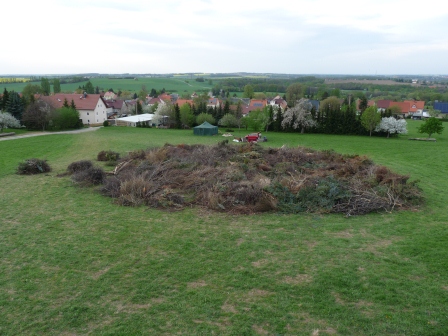
The village saves all of its waste wood (tree trimmings, scrap lumber, etc.) throughout the year, bringing them to a designated space in a farmer’s field during the week before Hexenbrennen (‘witch burning’). The wood is all pushed into a huge pile, upon which is placed the Hexen (witch). Don’t worry, it’s not a real witch, but an effigy made of wood and fabric. Sometimes, perhaps after a particularly bad winter, they burn more than one witch!
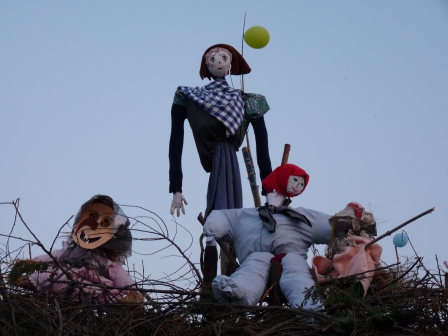
Hexenbrennen is Saxony’s version of Walpurgisnacht (Walpurgis’ Night), a traditional spring festival that takes place on April 30th in large parts of Central and Northern Europe. This date is exactly 6 months from All Hallow’s Eve (Halloween). It is named after Saint Walpurga, an English missionary who was canonized on May 1st (May Day) in the year 870. The eve of May day, traditionally celebrated with dancing, came to be known in Germany as Walpurgisnacht. On this night, witches are reputed to hold a large celebration on the Brocken (the highest mountain in the Harz mountain range) and await the arrival of spring.
The burning of people that were thought to be witches was common throughout Europe between the 15 and 18th Centuries. Estimates vary, but perhaps as many as 50,000 accused witches (about three-quarters of whom were women) were killed in this manner. The peak of the witch hunting phenomenon occurred in central and southern Germany from 1561 to 1670. Hexenbrennen may be a carry-over from this legacy, but it has long left its tormented history behind, and despite potential misogynist undertones, it is now a fun family celebration that we looked forward to attending.
We arrived around sunset with our generous hosts Andreas and Regina after enjoying some warm-up beverages at their home. They introduced us to their friends, including the man who owns the house that we stayed in when we visited last September. Everyone was very welcoming and the whole village seemed to know that we were visiting Canadians (it’s a small village and word gets around). Many were glad to speak with us, using their limited English and my extremely limited German.
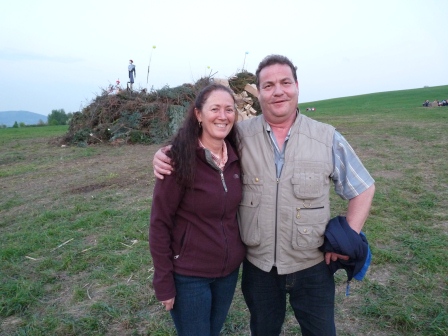
The local volunteer fire department was serving food and drink as a fundraiser. We tried all of the food, washed down with generous amounts of German beer. I enjoyed the herring sandwich (strips of pickled herring on a white bun soaked in herring juice), but it wasn’t to Diane’s liking. We both really liked the wurst (sausage, pronounced ‘vurst’) and delicious schaschlik (a shish kabob of pork).
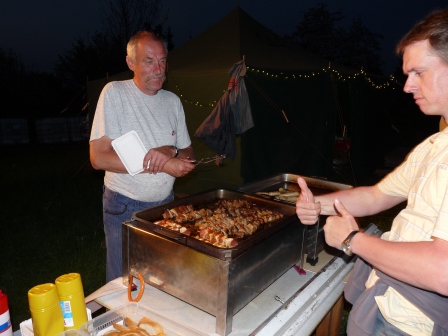
Soon after nightfall, the children of the village were armed with flaming swords and marched up the hill in a procession. They approached the huge pyre, circled it, and threw their torches into the tangle.
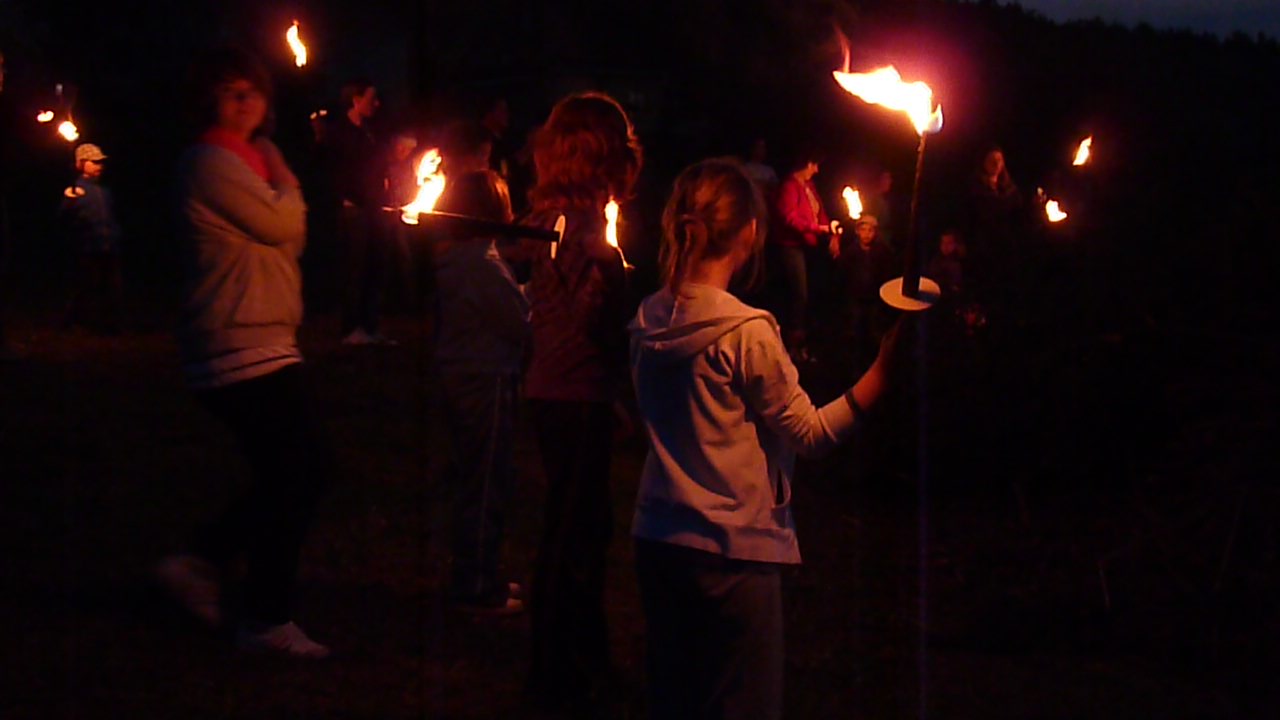
The fire started slowly at first, but soon grew into a massive inferno. The heat it threw off was overpowering, and it was necessary to stand at least 20 meters away.

At some point in the proceedings, we climbed the hill with Andreas to look out across the countryside. In the distance we could see 8 fires burning in other villages, each casting an eerie orange glow. By tradition the villages compete to amass the largest wood pile, something that when lit will be seen for miles around and be the envy of all the other villages. The people in Schwarznaußlitz seemed a little bit dismayed by the fact that their wood pile wasn’t larger, and talked fondly of the good old days when it was much bigger. They spoke nostalgically of the grandest pile they’d ever seen, in which village it was located, and in what year.
Also by tradition, the young men of the villages compete in a related ritual. They try to sabotage the other villages’ plans by igniting their wood piles before the big night. As a result, it is necessary for the young men of each village to provide round-the-clock security for their own wood piles from their inception until the night of Hexenbrennen, which is typically about a week.
The young men of Schwarznaußlitz take this to a rather extreme level. Each night they protect their wood pile while sitting beside it on old couches. They also erect a massive guard tower equipped with high powered search lights to monitor the perimeter.

At night the farmer’s field where the wood pile is located resembles a prison camp, with scheduled watches, posted sentries, and foot patrols. Armed with pellet guns, radios, adrenaline, and beer, they guard their pyre with paramilitary bravado.

Although it is a now a crime to burn another village’s wood pile before the big night (a huge uncontrolled fire, even out in a farmer’s field, could be dangerous), it does happen. In a bold nighttime sortie, someone set fire to the couches of the security squad of the neighbouring village Singwitz. The cunning perpetrators have yet to be apprehended. I heard stories of the sneak attacks that the Schwarznaußlitz men had repelled, and how the assailants from other villages had repeatedly been denied. At first I thought these stories were concocted or the result of overactive, beer-fired imaginations, but when on the final night I was told that they repelled 7 different groups of invaders, I started to believe. Once again this year, the young men of Schwarznaußlitz were triumphant, and the wood pile survived until the time of its scheduled immolation.
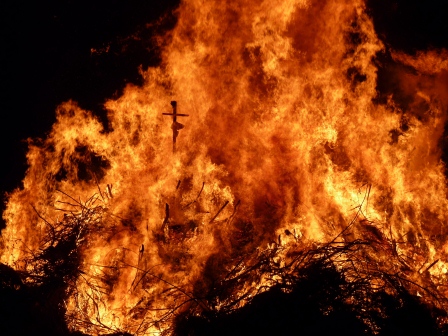
We greatly enjoyed our repeat visit to Schwarznaußlitz. We would like to thank Andreas, Regina, Lilo, Stephan, and Juliane for hosting us. We are very fortunate to know them, and it was great to visit them during Hexenbrennen and to participate in this unique event.
How fortunate you are to experience the non-touristic events with the real people. Loved the witch burning photo!
Hugs, Moe and Arlene
So cool! In my next life I’m going to travel like you guys – this time around it’s kids, grandkids, – adventures to be sure, but different. My ‘new frontier’ is close to home! Loving it to be sure.
The phrase ‘ burn the witch’ reminded me of a movie I saw when I was about 13, starring Vincent Price. It was called Witchfinder General, but its North American release was renamed The Conquerer Worm. I know there’s a reason, but I forget why. OMG that move scared the crap out of me, and my young teen heart went out to those young women who were misunderstood and burned as witches. Ah, we humans are oh so interesting. Safe and rewarding travels! Glad you are posting!
Great bloc patrick…more witch burning please
I’ll see if I can scrounge up a burnt witch for you Martin, but they’re in short supply these days. Would a singed one do?